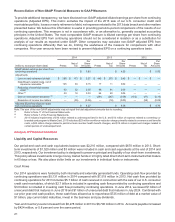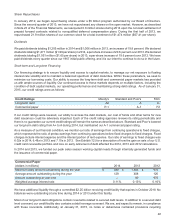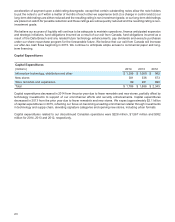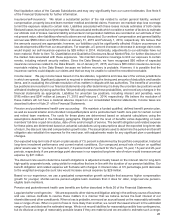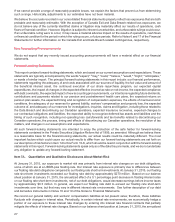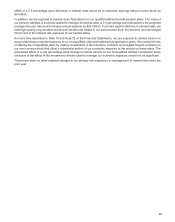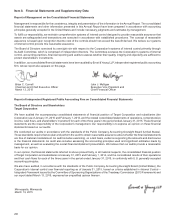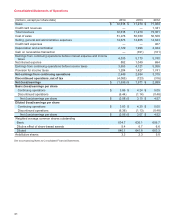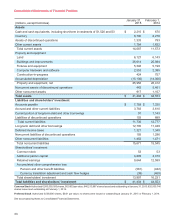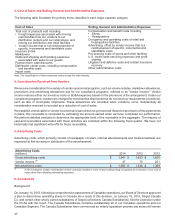Target 2014 Annual Report Download - page 32
Download and view the complete annual report
Please find page 32 of the 2014 Target annual report below. You can navigate through the pages in the report by either clicking on the pages listed below, or by using the keyword search tool below to find specific information within the annual report.If we cannot provide a range of reasonably possible losses, we explain the factors that prevent us from determining
such a range. Historically, adjustments to our estimates have not been material.
We believe the accruals recorded in our consolidated financial statements properly reflect loss exposures that are both
probable and reasonably estimable. With the exception of Canada Exit and Data Breach-related loss exposures, we
do not believe any of the currently identified claims or litigation may materially affect our results of operations, cash
flows or financial condition. However, litigation is subject to inherent uncertainties, and unfavorable rulings could occur.
If an unfavorable ruling were to occur, it may cause a material adverse impact on the results of operations, cash flows
or financial condition for the period in which the ruling occurs, or future periods. Refer to Notes 6 and 17 of the Financial
Statements for further information on the Canada Exit and Data Breach-related contingencies, respectively.
New Accounting Pronouncements
We do not expect that any recently issued accounting pronouncements will have a material effect on our financial
statements.
Forward-Looking Statements
This report contains forward-looking statements, which are based on our current assumptions and expectations. These
statements are typically accompanied by the words "expect," "may," "could," "believe," "would," "might," "anticipates,"
or words of similar import. The principal forward-looking statements in this report include: our financial performance,
statements regarding the adequacy of and costs associated with our sources of liquidity, the fair value and amount of
the beneficial interest asset, the continued execution of our share repurchase program, our expected capital
expenditures, the impact of changes in the expected effective income tax rate on net income, the expected compliance
with debt covenants, the expected impact of new accounting pronouncements, our intentions regarding future dividends,
contributions and payments related to our pension and postretirement health care plans, the expected returns on
pension plan assets, the expected timing and recognition of compensation expenses, the effects of macroeconomic
conditions, the adequacy of our reserves for general liability, workers' compensation and property loss, the expected
outcome of, and adequacy of our reserves for investigations, inquiries, claims and litigation, including those related to
the Data Breach and discontinuing our Canadian operations, expected insurance recoveries, expected changes to
our contractual obligations and liabilities, the expected ability to recognize deferred tax assets and liabilities and the
timing of such recognition, including net operating loss carryforwards and tax benefits related to discontinuing our
Canadian operations, the process, timing and effects of discontinuing our Canadian operations, the resolution of tax
matters, and changes in our assumptions and expectations.
All such forward-looking statements are intended to enjoy the protection of the safe harbor for forward-looking
statements contained in the Private Securities Litigation Reform Act of 1995, as amended. Although we believe there
is a reasonable basis for the forward-looking statements, our actual results could be materially different. The most
important factors which could cause our actual results to differ from our forward-looking statements are set forth on
our description of risk factors in Item 1A to this Form 10-K, which should be read in conjunction with the forward-looking
statements in this report. Forward-looking statements speak only as of the date they are made, and we do not undertake
any obligation to update any forward-looking statement.
Item 7A. Quantitative and Qualitative Disclosures About Market Risk
At January 31, 2015, our exposure to market risk was primarily from interest rate changes on our debt obligations,
some of which are at a LIBOR-plus floating-rate. Our interest rate exposure is primarily due to differences between
our floating rate debt obligations compared to our floating rate short term investments. At January 31, 2015, our floating
rate short-term investments exceeded our floating rate debt by approximately $270 million. Based on our balance
sheet position at January 31, 2015, the annualized effect of a 0.1 percentage point decrease in floating interest rates
on our floating rate short-term investments, net of our debt obligations, would decrease earnings before income taxes
by approximately $0.3 million. In general, we expect our floating rate debt to exceed our floating rate short-term
investments over time, but that may vary in different interest rate environments. See further description of our debt
and derivative instruments in Notes 18 and 19 of the Notes to Financial Statements.
We record our general liability and workers' compensation liabilities at net present value; therefore, these liabilities
fluctuate with changes in interest rates. Periodically, in certain interest rate environments, we economically hedge a
portion of our exposure to these interest rate changes by entering into interest rate forward contracts that partially
mitigate the effects of interest rate changes. Based on our balance sheet position at January 31, 2015, the annualized
27






